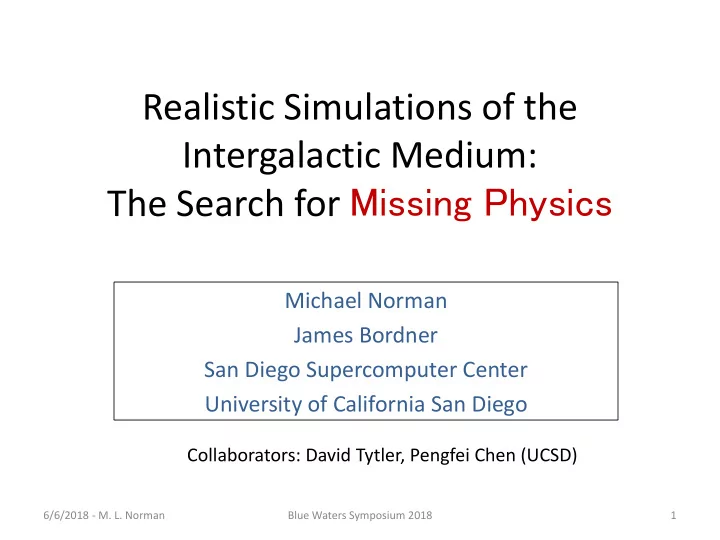

Realistic Simulations of the Intergalactic Medium: The Search for Missing Physics Michael Norman James Bordner San Diego Supercomputer Center University of California San Diego Collaborators: David Tytler, Pengfei Chen (UCSD) 6/6/2018 - M. L. Norman Blue Waters Symposium 2018 1
Observing the intergalactic medium in quasar absorption line spectra Lyman α forest Source: M. Murphy 6/6/2018 - M. L. Norman Blue Waters Symposium 2018 2
The Cosmic Web: Origin of the Ly α forest absorption quasar Cosmic web formed by gravitational clustering of dark matter and baryons (H and He) Hundreds of millions of lightyears 6/6/2018 - M. L. Norman Blue Waters Symposium 2018 3
Simulation v. observation: good qualitative agreement observed Kirkman & Tytler (1997) simulated Zhang et al. (1997) 6/6/2018 - M. L. Norman Blue Waters Symposium 2018 4
N=1024 3 L = 80 Mpc Baryon Overdensity, z=3 Jena et al. (2005) 6/6/2018 - M. L. Norman Blue Waters Symposium 2018 5
A small but persistent discrepancy has emerged between sim. & obs. as higher precision has been achieved Possible Explanation Finding Observational systematics NO Simulation not converged NO Simulation box size too small NO Missing IGM physics MAYBE Missing galaxy HI absorption MAYBE This PRAC project 6/6/2018 - M. L. Norman Blue Waters Symposium 2018 6
Quantifying the discrepancy: Flux PDF Too many Not enough low transmission high transmission 6/6/2018 - M. L. Norman Blue Waters Symposium 2018 7
An inverted T- ρ relation in the IGM improves agreement! Inverted: lower density gas is hotter Bolton et al. (2008) 6/6/2018 - M. L. Norman Blue Waters Symposium 2018 8
How to obtain an inverted T- ρ relation? Treat quasars as time-dependent point sources rather than as a homogeneous UV background Standard model Quasar model IGM ionized by homogeneous UVB IGM ionized by quasar point sources UVB 6/6/2018 - M. L. Norman Blue Waters Symposium 2018 9
The Enzo Simulations f(He III) z=4 z=3.5 z=3 z=2 z=4 z=3.5 z=3 z=2 temperature Range of spectral slopes F=( ν / ν 0 ) - β within obs. Enzo+MGFLD RT (Dan Reynolds) • • range QSOs randomly placed in halos • • Reionization by galaxies handled with UVB according to QLF every 45 Myr 1024 3 Cartesian grids; 80 & 126 Mpc boxes • • 5 energy groups 54.4 – 400 eV 6/6/2018 - M. L. Norman Blue Waters Symposium 2018 10
Implicit Multi-Group Flux Limited Diffusion Global linear system solves performed with the HYPRE library (LLNL) 6/6/2018 - M. L. Norman Blue Waters Symposium 2018 11
Why Multifrequency RT? A: QSOs have hard UV spectrum [54.4,65] eV [65,75] eV [75,125] eV [125,155] eV [155,400] eV photoheating 6/6/2018 - M. L. Norman Blue Waters Symposium 2018 12
Synthetic HI absorption spectra @ z=4 6/6/2018 - M. L. Norman Blue Waters Symposium 2018 13
Synthetic HI absorption spectra @ z=2 6/6/2018 - M. L. Norman Blue Waters Symposium 2018 14
Does it improve agreement with data? 6/6/2018 - M. L. Norman Blue Waters Symposium 2018 15
The flux power spectrum is still discrepant 6/6/2018 - M. L. Norman Blue Waters Symposium 2018 16
Summary and Conclusions • We have carried out simulations of the Lyman alpha forest modeling QSOs as discrete point sources • Inhomogeneous He II reionization and heating have a surprisingly small effect on the H I observables, compared to standard model which uses a UVB • Subtle and not-so-subtle discrepancies remain between models and observations, suggesting there is still some Missing Physics – Resolved galaxy halos? New PRAC – New dark matter physics? 6/6/2018 - M. L. Norman Blue Waters Symposium 2018 17
Rollup • Key Challenges : high fidelity simulation of the IGM including inhomogeneous quasar ionization and heating • Why it Matters: may explain discrepancy between theory and observation • Why Blue Waters : capability and capacity to develop and run very large, computationally and memory intensive simulations • Accomplishments : high-res run completed and analyzed • Blue Waters team contributions : assistance with topology- aware scheduling • Broader Impact : drove the development of MGFLD capability for the Enzo community code • Shared Data : none yet • Products : MGFLD capability in Enzo code, papers in prep. 6/6/2018 - M. L. Norman Blue Waters Symposium 2018 18
RESERVE SLIDES 6/6/2018 - M. L. Norman Blue Waters Symposium 2018 19
Why Blue Waters is Needed • Quasar model requires 3D time-dependent multifrequency radiative transfer – Very computationally intensive • Scale separation requires very large grids – Must resolve Ly α forest absorbers (25 kpc) in a box large enough to contain hundreds of quasars (100 Mpc) 4000 3 grids (target) • Model development requires high throughput for experimentation at scale Progress requires combination of capacity and capability that only Blue Waters can provide 6/6/2018 - M. L. Norman Blue Waters Symposium 2018 20
Helium reionization by time-dependent quasars: Enzo MGFLD simulation on Blue Waters He ++ He + Projected He+ fraction 186 Mpc 6/6/2018 - M. L. Norman Blue Waters Symposium 2018 21
Redshift Evolution of χ (He ++ ) and T He++ volume fraction Temperature 6/6/2018 - M. L. Norman Blue Waters Symposium 2018 22
Inhomogeneous heating of the IGM by quasars 1024 3 Enzo-MGFLD on Blue Waters z=3.41 Baryon density Z=3.41 Baryon temperature 118 Mpc 6/6/2018 - M. L. Norman Blue Waters Symposium 2018 23
Inhomogeneous heating of the IGM by quasars 1024 3 Enzo-MGFLD on Blue Waters Z=3.41 He + fraction Photoheating rate 118 Mpc 6/6/2018 - M. L. Norman Blue Waters Symposium 2018 24
Recommend
More recommend